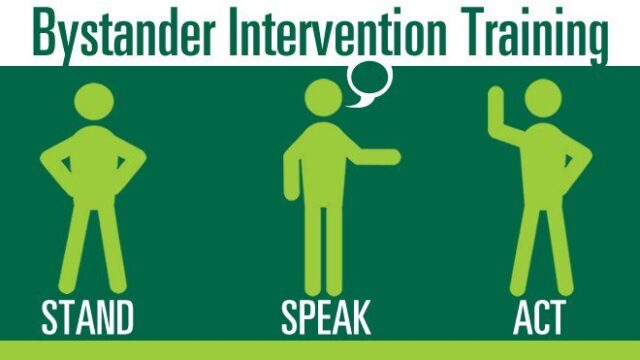
In an unsettling revelation of the global epidemic of sexual assault, victims and society at large are marred by its devastating impacts. The violation not only leaves the victims emotionally and physically scarred but also lays bare a societal vulnerability, exposing communities to the disruptive aftereffects of these heinous acts. According to the Rape, Abuse & Incest National Network (RAINN), an American is sexually assaulted every 68 seconds, yet a vast majority of these incidents go unreported, and offenders remain free, unaccountable for their actions. This troubling statistic emphasizes an urgent need to address not just the prevalence of sexual assault but the systemic lack of intervention and support for the victims.
Amidst these alarming statistics, bystander intervention emerges as a formidable ally in the fight against sexual assault. It embodies a proactive stance where community members, equipped with the right skills and awareness, are empowered to intervene in unfolding assault scenarios. This shift from passive witnessing to active intervention holds the promise of transforming communities, making them safer and more responsive. The embrace of bystander intervention represents a step towards collective responsibility, where each member is a guardian of the other’s safety, fostering environments where respect, dignity, and safety are not just aspirational but are realized and upheld.
 Understanding Bystander Intervention
Understanding Bystander Intervention
Bystander intervention is the act of stepping in to prevent a potentially harmful situation, such as sexual assault, when others might simply stand by and watch. This social behavior promotes community safety and wellbeing.
However, psychological barriers like the bystander effect—where individuals are less likely to offer help to a victim when other people are present—and diffusion of responsibility—where each person assumes someone else will intervene—often inhibit this altruistic initiative. The innate fear of retaliation or getting involved in a confrontational scenario exacerbates inaction.
Therefore, the public needs to be made aware of instances where individuals have successfully thwarted potential assaults, highlighting the need to transcend these mental barriers and actively foster a culture of mutual protection and safety.

Steps to Effective Bystander Intervention
1. Recognize the Signs
Identifying potential sexual assault scenarios is the first step in initiating bystander intervention. Readers should be educated on the subtle and overt cues of unfolding assault situations, including recognizing power imbalances, isolating behaviors, and non-consensual actions.
2. Assessment
Equipping oneself with strategies to accurately assess the situation involves gauging the safety of intervention, the victim’s vulnerability, and the immediacy of action required, ensuring that the bystander’s involvement leads to a positive outcome without escalating the situation.
3. Intervention Techniques
Direct methods involve confronting the situation head-on, while indirect methods focus on distraction techniques or seeking help, ensuring the victim’s safety and the perpetrator’s accountability in various contexts. This includes getting assistance from a sexual assault attorney in Houston to legally protect victims and hold perpetrators accountable.
4. Legal & Ethical Considerations
It’s paramount to comprehend the legal and ethical boundaries of intervention, ensuring that the intervention is not only courageous but also lawful and morally sound.

Role of Education & Training
Educational Programs
Various programs and training initiatives exist that are designed to equip individuals with bystander intervention skills. These are tailored to enhance the understanding, confidence, and responsiveness of potential bystanders, turning passive observers into active interveners.
Effectiveness
An examination of these educational programs reveals significant impacts in real-world scenarios. They have been instrumental in raising awareness, enhancing the skill set of individuals, and fostering an environment where bystanders feel empowered and obligated to intervene in potential sexual assault situations.
Implementation
There are actionable strategies to broaden the reach of bystander intervention education. By integrating these programs into the curriculums of schools, protocols of workplaces, and norms of communities, we can create a pervasive culture of awareness, readiness, and mutual care in preventing sexual assault.

The Societal Impact
Community Safety
Widespread bystander intervention is instrumental in enhancing community safety. When individuals are equipped and willing to intervene in unsafe situations, it directly reduces the occurrence of sexual assault. This proactive approach not only protects potential victims but fosters a communal ethos of vigilance and care.
Cultural Change
Empowering individuals to intervene signals a significant shift in societal norms and attitudes towards sexual assault. It transforms a culture of silence and inaction into one of responsibility and action, where community members actively participate in preventing assault. This change is crucial in reducing the stigma associated with sexual assault and fostering an environment where safety and respect are paramount.
Survivor Support
Bystander intervention plays a key role in supporting survivors of sexual assault. When community members intervene, it validates the experiences of survivors, offering them immediate support and reducing the trauma associated with the assault. This communal support is integral in the healing process, reaffirming societal commitment to justice and care for survivors.

The Role of Individuals
Learning and Education
Every individual has a role to play in learning about and understanding the mechanisms of effective bystander intervention. Personal education is the foundation, necessitating ongoing learning, adaptation, and growth to respond effectively to the dynamic challenges associated with preventing sexual assault.
Sharing Knowledge and Awareness
Equally important is the responsibility to share learned knowledge and awareness with others. Each person can become an agent of change, spreading insights, and tools within their circles of influence, thus contributing to a ripple effect that can transform societal norms and behaviors, making communities safer for everyone.
The adoption of bystander intervention is not just a remedy but a preventive measure that arms society with the tools to combat sexual assault proactively. Each individual’s commitment to intervene and support, nurtured through education and a shift in societal norms, has the power to transform communities into sanctuaries of safety and respect. In this collective endeavor, every action counts, laying the foundation for a world where sexual assault is not just confronted but is actively prevented, ensuring dignity, respect, and safety for all.

 Understanding Bystander Intervention
Understanding Bystander Intervention







